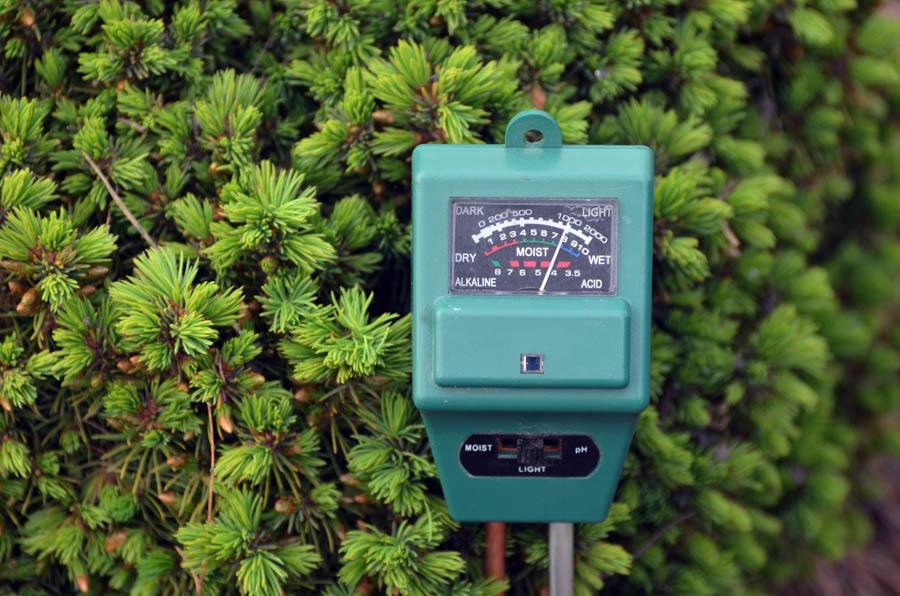Down and Dirty 8: Tips for Testing Soil pH at Home with a Soil pH Meter

Down and Dirty Southern California Gardening
A weekly GardenZeus article series to help gardeners succeed in Southern California’s unique climates and growing conditions.
Post 8: Tips for Testing Soil pH at Home with a Soil pH Meter
GardenZeus receives commissions for purchases made through links in this post. There is no additional cost to you.
Ignore soil pH in your Southern-California garden soil at your (and your plants’) own risk!
Most soils in Southern California are alkaline, and depending upon severity and plant tolerances, this can wreak varying degrees of havoc in gardens and landscapes. If you have alkaline soil, it’s important to monitor soil pH, choose plants and make other decisions accordingly, improve soil pH, and address the issues that soil alkalinity creates.
Soil pH meters may seem an efficient and economical alternative to lab testing for soil pH, and for the busy Southern-California gardener there is appeal to being able to insert a probe or meter into a soil sample to get a reading at home. However, time and care are still needed to obtain accurate readings.
As a professional I have been satisfied over years with the general accuracy of soil pH meters (often with a margin of error of about 0.1 to 0.3 in the pH scale of 1 – 14) for most general, urban gardening and landscaping purposes when sampling and testing is done carefully and per instructions provided by the manufacturer.
Repeated testing of specific, discrete soil areas over time using a soil pH meter (or using pH strips as described in the prior Down and Dirty article) can be more useful than occasional lab tests with samples combined from multiple garden or yard areas (a composite sample). The greatest benefits from testing soil pH at home are often realized when testing before planning a new landscape or garden, before each season or new planting, before and after treating soils for alkalinity, or at various intervals depending upon plant species and planting purpose. Individual readings from pH meters may be inaccurate. If you test only occasionally, a lab test with a composite sample is usually best.
One drawback of soil pH meters is that they are more limited in their ability to measure alkalinity in soil than acidity, and often top out in measurement range at about 8 pH. Soil alkalinity may exceed 8 pH in Southern California. If your soil pH meter maxes out at 8, investigate further. See the prior article in this series, Down and Dirty 7: Mudpies and Fizz: Easy Home Tests for Soil pH for instructions about testing higher-alkalinity soils at home using pH strips.
A variety of soil pH meters are available. Exact instructions for use, the time needed for the meter to register a reading, and other details. methods, and functions may vary. For an inexpensive-but-effective soil pH meter, GardenZeus recommends this popular model.
Professional-quality soil pH meters are also available.
It’s important to use distilled water when preparing soil mixes for pH testing at home because it has a neutral pH and won’t affect test results. Most municipal water is alkaline and will skew your results. Distilled water can be purchased at most grocery stores that sell bottled water.
While specific testing methods may vary by soil pH meter, accurate results generally require taking a large soil sample from 2 to 6 inches below your soil’s surface. Avoid sampling the top inch or two of soil as pH may be more variable within the “O” layer near the soil surface, and may be different than the pH of mineralized topsoil that we want to test a few inches down. Remove and keep out mulch, surface amendments, fertilizers, compost, organic matter such as roots and leaf litter, and anything else other than soil from your sample as much as possible.
Put the soil sample into a bucket or similar container, and mix with distilled water to the consistency of wet mud. Allow the wet soil sample to sit for at least 30 to 60 minutes before testing. Clean the probe(s) on your soil meter after testing each soil sample.
Extreme results are probably errors or variation within a limited soil area. The average of multiple tests over time tends to be the most accurate.
GardenZeus recommends testing soil pH separately for every planting area and in any new planting beds both before and after amending. Soil pH can vary significantly within a single yard or garden. Many factors or conditions in soil can affect pH and produce a surprising or varied result within a small soil area, from prior anaerobic conditions and chronically wet areas, to a history of pets or wild animals urinating in an area, to detergents or chemicals that may have been dumped or drained into soil.
“Down and Dirty Southern California Gardening” is a weekly GardenZeus article series in which expert Darren Butler shares more than 20 years of experience about what works and what doesn’t with gardening in Southern California:
Post 7: Mudpies and Fizz: Easy Home Tests for Soil pH
Post 9: Insect Pests and Diseases Usually Aren’t the Problem
All articles in this series: Down and Dirty Southern California Gardening
GardenZeus Calfornia climate zones
Enter your California zip code for customized advice by plant